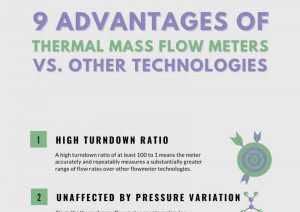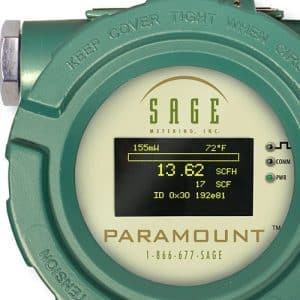Flow Control Magazine published Bob Steinberg’s article “Specifying a thermal mass flowmeter for gases,” stating nine distinct advantages of a thermal mass flow meter. The article additionally states everything you need to know about spec’ing the meter to ensure accuracy and success in a gas flow application.
What are the advantages of thermal mass flow meters?
There are nine advantages or benefits when using a thermal mass flow meter versus other technologies. They are:

- Thermal mass flow meters have a high turndown ratio of at least 100 to 1, meaning that they accurately and repeatably measure a substantially greater range of flow rates than other flowmeter technologies.
- They are not affected by pressure variations since the thermal meter counts molecules.
- They have extremely low pressure-drop (measuring in inches of water).
- Most thermal mass flow meters have extreme low-end sensitivity, capable of detecting even a pilot light in a natural gas line.
- Thermal mass flow meters have no moving parts. The technology depends on the heat transfer passing a pair of resistance temperature detectors (RTDs) comprising stable platinum wound sensors protected with a stainless-steel sheath.
- They are easy to install, particularly the Sage Metering insertion models, which simply require a weldolet to accept the Sage isolation valve assembly. There is no cutting into the pipe to insert spool sections.
- Thermal mass flow meters offer extraordinary repeatability and reproducibility with negligible maintenance over a broad flow range.
- Some thermal mass flow meters, like the Sage Metering Paramount and Prime, offer a simple calibration verification routine to reassure the user that the meter is performing accurately without removing the flow meter from the installation.
- They are economical, mainly since they eliminate the cost and installation of ancillary temperature and pressure transmitters.

What are the Disadvantages of Thermal Mass Flow Meters?
What are the disadvantages, limitations, or challenges? Read “All You Ever Wanted to Know about Thermal Mass Flow Meters.”
How do they stack up against other technologies?
How do they stack up against a differential pressure (DP) meter, Coriolis meter, positive displacement meter, turbine meter, vortex, differential pressure, orifice plates, or Venturi flow meter? Read the Flow Control article by Bob Steinberg to learn more.
If you enjoyed this, you might be interested in our white paper on the Fundamentals of Thermal Mass Flow Measurement.

